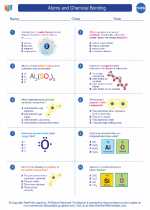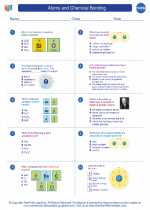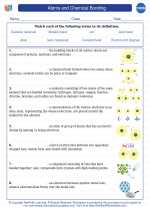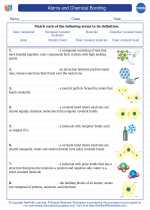Atoms and Chemical Bonding
Atoms are the basic building blocks of matter. They are made up of three subatomic particles: protons, neutrons, and electrons. Protons have a positive charge, neutrons have no charge, and electrons have a negative charge. The protons and neutrons are located in the nucleus, while the electrons orbit around the nucleus in various energy levels or shells.
Chemical bonding is the process by which atoms are held together to form molecules and compounds. There are three main types of chemical bonds: ionic, covalent, and metallic.
Ionic Bonding
An ionic bond is formed when one or more electrons are transferred from one atom to another. This results in the formation of positively charged ions (cations) and negatively charged ions (anions). These oppositely charged ions are then attracted to each other, forming an ionic bond. Ionic bonds are typically formed between a metal and a nonmetal.
Covalent Bonding
A covalent bond is formed when atoms share one or more pairs of electrons. This sharing of electrons allows each atom to achieve a full outer electron shell, making the resulting molecule more stable. Covalent bonds are typically formed between two nonmetals.
Metallic Bonding
Metallic bonding occurs in metals, where the outer electrons of the atoms are free to move throughout the structure. This "sea" of delocalized electrons holds the metal atoms together in a lattice structure, giving metals their unique properties such as conductivity and malleability.
Study Guide
- What are the three subatomic particles that make up an atom?
- Where are protons and neutrons located within an atom?
- What is the charge of a proton, neutron, and electron?
- Describe the structure of an atom, including the location of the subatomic particles.
- What is a chemical bond?
- What are the three main types of chemical bonds?
- Describe ionic bonding and provide an example of a compound formed by ionic bonding.
- Describe covalent bonding and provide an example of a compound formed by covalent bonding.
- What is metallic bonding and what are some properties of metals that result from metallic bonding?
- Explain how the formation of chemical bonds relates to the stability of atoms and molecules.
Studying the topics of atoms and chemical bonding is crucial for understanding the behavior and interactions of matter at the molecular level. It forms the basis for understanding the properties of elements and compounds, as well as the processes involved in chemical reactions.
[Atoms And Chemical Bonding] Related Worksheets and Study Guides:
.◂Chemistry Worksheets and Study Guides High School. Atoms and Chemical Bonding

 Worksheet/Answer key
Worksheet/Answer key
 Worksheet/Answer key
Worksheet/Answer key
 Vocabulary/Answer key
Vocabulary/Answer key
 Vocabulary/Answer key
Vocabulary/Answer key
